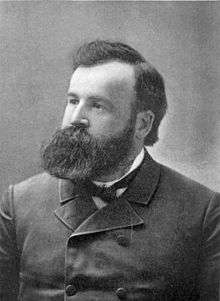William Hamilton Gibson
| William Hamilton Gibson | |
|---|---|
 W. H. Gibson | |
| Born |
October 5, 1850 Sandy Hook, Connecticut |
| Died | July 16, 1896 |
| Nationality | American |
| Fields | Natural history |
| Known for | drawings |
| Author abbrev. (botany) | W.H.Gibson |
William Hamilton Gibson (October 5, 1850 – July 16, 1896) was an American illustrator, author and naturalist.
Biography
Gibson was born in Sandy Hook, Connecticut, of an old, distinguished New England family; one of his great-great-grandfathers was the jurist Richard Dana (1699–1772), who was the great-grandfather of the famous author Richard Henry Dana, Jr.[1] The financial failure and in 1868 the death of Gibson's father, a New York broker, put an end to his studies in the Brooklyn Polytechnic Institute and made it necessary for him to earn his own living. From the life insurance business, in Brooklyn, he soon turned to the study of natural history and illustration, he had sketched flowers and insects when he was only eight years old, had long been interested in botany and entomology, and had acquired great skill in making faux flowers. His first drawings, of a technical character, were published in 1870.[2]
He rapidly became an expert illustrator and a remarkably able wood-engraver, while he also drew on stone with great success. He drew for The American Agriculturist, Hearth and Home, and Appletons American Cyclopaedia; for The Youth's Companion and St Nicholas; and then for various Harper publications, especially Harper's Monthly magazine, where his illustrations first gained popularity. He died of apoplexy, brought on by overwork at Washington, Connecticut, where he had had a summer studio, and where in a great boulder is inset a relief portrait of him by H. K. Bush-Brown. He was an expert photographer, and his drawings had a nearly photographic and almost microscopic accuracy of detail which slightly lessened their artistic value, as a poetic and sometimes humorous quality somewhat detracted from their scientific worth. Gibson was perfectly at home in black-and-white, but rarely (and feebly) used colors. He was a popular writer and lecturer on natural history.[2]
Works
Gibson illustrated S. A. Drake's In the Heart of the White Mountains, C. D. Warner's New South, and E. P. Roe's Nature's Serial Story; and his own books, The Complete American Trapper (1876; revised, 1880, as Camp Life in the Woods); Pastoral Days: or, Memories of a New England Year (1880); Highways and Byways (1882); Happy Hunting Grounds (1886); Strolls by Starlight and Sunshine (1890); Sharp Eyes: a Rambler's Calendar (1891); Our Edible Mushrooms and Toadstools (1895); Eye Spy: Afield with Nature among Flowers and Animate Things (1897); and My Studio Neighbours (1898).[2]
References
- ↑
- Adams, John Coleman (1901). William Hamilton Gibson: Artist—Naturalist—Author. New York: G. P. Putnam's Sons.
- 1 2 3 Chisholm 1911, p. 944.
- ↑ IPNI. W.H.Gibson.
- Attribution
 This article incorporates text from a publication now in the public domain: Chisholm, Hugh, ed. (1911). "Gibson, William Hamilton". Encyclopædia Britannica. 11 (11th ed.). Cambridge University Press. p. 944.
This article incorporates text from a publication now in the public domain: Chisholm, Hugh, ed. (1911). "Gibson, William Hamilton". Encyclopædia Britannica. 11 (11th ed.). Cambridge University Press. p. 944.
External links
| Wikimedia Commons has media related to William Hamilton Gibson. |
- Works by William Hamilton Gibson at Project Gutenberg
- Works by or about William Hamilton Gibson at Internet Archive